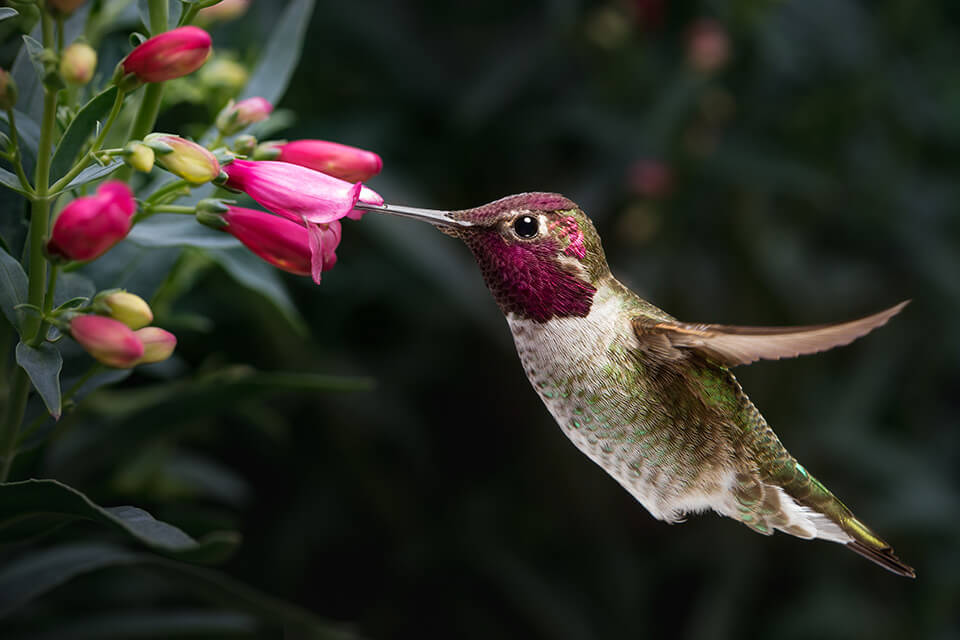We had a great time in the forest last Tuesday.
The forest is beginning to wake up after our long winter. Our senses were awakened with the colours and smells of spring.
Hummingbirds were stars of the day and after a swing and a climb we settled down to explore these amazing creatures.
Hummingbirds are only found in the Americas. We have two species of hummingbirds, the Anna and Rufous. Annas hummingbirds stay year round but the Rufous appears in late February and leaves again in August to make the trek back down the coast to warmer climates.
We focused our attention on the life cycle of the Annas. I had brought along a male and female specimens for the children to explore. Hummingbirds travel up to 40km. These little birds beat their wings up to 40-50 times per SECOND! Of course we had to try this out to much giggling and wiggling arms. The wing joints are very similar to human joints at the shoulder which enable this beautiful little bird to fly backwards, hover sideways and even head upside down. A very giggly display of backward flight took place!
30% of their body is made up of muscle, they only weigh as much as a 5 cent coin.
The tiny legs are used for perching as they cannot walk or hop but can scoot sideways when perching.
The bird has a very high metabolism and needs to spend the day eating. On an average day they can visit up to 1000 flowers and eat over 100 insects. Equivalent to each of the children making their way through 200 burgers in a day. Some liked this idea…..
We explored the various flowers that attract hummingbirds discussing the shape and colour. Trumpet shaped flowers like flowering red currents are an excellent source of food. Colours that attract the hummingbird are red, pink and purple. We went off to try and spot some of these plants, the children soon spotting some flowering red currents. We used one of our hummingbirds to explore how the birds beak is adapted to fit
into the cone flowers. We also checked out their tongue exploring how the nectar is absorbed using a tissue and water to show how the tongue sucks up the nectar. We had a few children that tried to absorb their water through their tongues to much mess but lots of giggles.
We moved onto a game next.
It is a hard life being a hummingbird. There are quite a few predators that would enjoy a
hummingbird for lunch. We set up some flowers in a circle each with some nectar inside. The hummingbird stood at the start cone. The rest of the children who represented stellar jays and crows stood at a cone close by. The predators had a die to roll. The hummingbird had to run to each flower picking up a nectar along the way.
Meanwhile the predators rolled the die. If a one, three or five was rolled the predators began the chase. The hummingbird could run to the safety of a cone positioned in the centre of the circle. If a hunt began then the hummingbird would have to pick up two nectars at each flower to make up for the lost energy. A nerve wracking game that had
the hummingbirds giggling with apprehension as they ran around the circle. So fun!
Next the life cycle. I had brought along an egg that had been abandoned in a nest, possibly the mother had been preyed upon by a bird or raccoon. I also brought along a nest. Hummingbirds lay two eggs that are the size of a tic tac. I passed around the egg and nest for everyone to explore.
The female will weave moss and lichen together with spiders web. The babies will stay in the nest for approximately three weeks. The chicks develop an amazing ability to help keep their nest clean by launching their poo out of the nest by lifting their bums up over the rim of the nest. I had a pic of this much to the children’s delight. Then a game.
We set up a nest with a couple of eggs inside. The hummingbird had to take care of her eggs but also leave to get food. A few stellar jays waited in the wings until she left then tried to head over to steal the eggs. We lost a few but those hummingbirds were ferocious protectors! Before we knew it it was time to head home. Looking forward to our next adventure!

